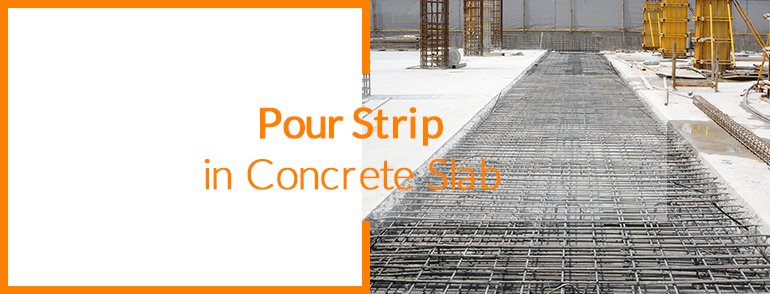Pour Strip in Concrete Slab

Pour Strip in Concrete Slab
Pour Strip is very necessary while constructing a concrete building including a large post-tensioning. Pour Strip, also called closure strip, is a temporary separation of the ground that allows floors to move freely. It is a section of concrete slab which is left open which helps to control shrinkage and elastic shortening. Pour strips are also used to give access for stressing of post tensioning tendons. For 30 to 60 days, pour strips are left open and then it is closed by placing concrete to complete slab continuity.
Condition to use Pour Strip
We can use pour strips on the building length which are as follows:
1.Closure Strip is not necessary to be constructed if the area is less than 250 Ft. (76M).
2.Closure Strip should be constructed at the center of the floor if the area is between 250Ft. and 325Ft. (76M to 99M).
3.Two types of closure strips should be constructed and before connecting we should leave for 60 days if the floor length is between 325Ft. to 400 Ft. (99 to 122M).
4.Closure Strip should be used as an expansion joint if the area is longer than 400 Ft. (122M).
The reinforcement helps to produce the continuity of the slab over the strip as the reinforcement extends from the concrete slab on each side into the closure strip. We can determine the width of a closure strip with the net distance needed to position a stressing jack between the two sides of the strip and terminate the stressing operation.
On the basis of actions (i.e. moments and shears) appearing at the location of the strip, we design the reinforcement over the closure strip. The location is estimated for a closure strip between two adjacent supports where the moments are generally small. In the same manner as the free edges, the stressing ends of the tendons terminating in the closure strip must also be cut, scaled and grouted.
Pour Strip is a gap between two adjacent slab pours and the gap is between 4 to 8 feet wide across the entire width of the slab section. Pour strips help to reduce the restraint forces which allow movement in the slabs before they are locked together or to cores or shear walls. It helps to reduce the forces due to shrinkage.
Between the two concrete placements, there are joints at predetermined locations in the slab which is known as construction joints. Construction joints help to control the crack by producing a planned temporary break between two slab regions.
When the tendons are stressed, the slabs located at each side of the pour strip must be completely separate so that we can get crack control benefit. The rebar and post-tensioning should be lap spliced inside the width of the pour strip.
After stressing tendons and before placing concrete to tie the two slabs together, the contractors should conclude whether the engineer needs the edges of the pour strip to remain fully shored. There may occur cracking and deflections from loads without edge reshores.
Closure Strip helps to reduce the problem of retaining that occur due to shrinkage and also helps to reduce many construction problems. The construction speed can be fast as dividing the floor into many parts with the help of closure strips makes the area smaller. We don’t have to spend much time in the construction with the help of pour strips. It reduces restraint-induced cracking and stresses in concrete structures. Hence, Pour Strip (Closure Strip) is a section in concrete slab which is left open for some days to reduce the cracking of the slab.
For more details, please visit Rebar People to avail our services and clarify your rebar related queries. You can contact us by phone and email.

